Microsoft RM-439 GSM 850/1900 Cellular Telephone Bluetooth User Manual Flamingo UG 01 clean US
Microsoft Mobile Oy GSM 850/1900 Cellular Telephone Bluetooth Flamingo UG 01 clean US
Manual

Nokia 7100 Supernova User
Guide

© 2008 Nokia. All rights reserved.
Nokia, Nokia Connecting People, and Navi are trademarks or registered
trademarks of Nokia Corporation. Nokia tune is a sound mark of Nokia
Corporation. Other product and company names mentioned herein may be
trademarks or tradenames of their respective owners.
Reproduction, transfer, distribution, or storage of part or all of the
contents in this document in any form without the prior written
permission of Nokia is prohibited.
US Patent No 5818437 and other pending patents. T9 text input software
Copyright (C) 1997-2007. Tegic Communications, Inc. All rights reserved.
Includes RSA BSAFE cryptographic or security protocol software
from RSA Security.
Java is a trademark of Sun Microsystems, Inc.
This product is licensed under the MPEG-4 Visual Patent Portfolio License
(i) for personal and noncommercial use in connection with information
which has been encoded in compliance with the MPEG-4 Visual Standard
by a consumer engaged in a personal and noncommercial activity and (ii)
for use in connection with MPEG-4 video provided by a licensed video
provider. No license is granted or shall be implied for any other use.
Additional information, including that related to promotional, internal,
and commercial uses, may be obtained from MPEG LA, LLC. See <http://
www.mpegla.com>.
Nokia operates a policy of ongoing development. Nokia reserves the right
to make changes and improvements to any of the products described in
this document without prior notice.
TO THE MAXIMUM EXTENT PERMITTED BY APPLICABLE LAW, UNDER NO
CIRCUMSTANCES SHALL NOKIA OR ANY OF ITS LICENSORS BE
RESPONSIBLE FOR ANY LOSS OF DATA OR INCOME OR ANY SPECIAL,
INCIDENTAL, CONSEQUENTIAL OR INDIRECT DAMAGES HOWSOEVER
CAUSED.
THE CONTENTS OF THIS DOCUMENT ARE PROVIDED "AS IS". EXCEPT AS
REQUIRED BY APPLICABLE LAW, NO WARRANTIES OF ANY KIND, EITHER
EXPRESS OR IMPLIED, INCLUDING, BUT NOT LIMITED TO, THE IMPLIED
WARRANTIES OF MERCHANTABILITY AND FITNESS FOR A PARTICULAR
PURPOSE, ARE MADE IN RELATION TO THE ACCURACY, RELIABILITY OR
CONTENTS OF THIS DOCUMENT. NOKIA RESERVES THE RIGHT TO REVISE
THIS DOCUMENT OR WITHDRAW IT AT ANY TIME WITHOUT PRIOR NOTICE.
The availability of particular products and applications and services for
these products may vary by region. Please check with your Nokia dealer for
details, and availability of language options.
Export controls
This device may contain commodities, technology or software subject to
export laws and regulations from the US and other countries. Diversion
contrary to law is prohibited.
The third-party applications provided with your device may have been
created and may be owned by persons or entities not affiliated with or
related to Nokia. Nokia does not own the copyrights or intellectual
property rights to the third-party applications. As such, Nokia does not
take any responsibility for end-user support, functionality of the
applications, or the information in the applications or these materials.
Nokia does not provide any warranty for the third-party applications.
BY USING THE APPLICATIONS YOU ACKNOWLEDGE THAT THE
APPLICATIONS ARE PROVIDED AS IS WITHOUT WARRANTY OF ANY KIND,
EXPRESS OR IMPLIED, TO THE MAXIMUM EXTENT PERMITTED BY
APPLICABLE LAW. YOU FURTHER ACKNOWLEDGE THAT NEITHER NOKIA
NOR ITS AFFILIATES MAKE ANY REPRESENTATIONS OR WARRANTIES,
EXPRESS OR IMPLIED, INCLUDING BUT NOT LIMITED TO WARRANTIES OF
TITLE, MERCHANTABILITY OR FITNESS FOR A PARTICULAR PURPOSE, OR
THAT THE APPLICATIONS WILL NOT INFRINGE ANY THIRD-PARTY PATENTS,
COPYRIGHTS, TRADEMARKS, OR OTHER RIGHTS.
FCC/INDUSTRY CANADA NOTICE
Your device may cause TV or radio interference (for example, when using a
telephone in close proximity to receiving equipment). The FCC or Industry
Canada can require you to stop using your telephone if such interference
cannot be eliminated. If you require assistance, contact your local service
facility. This device complies with part 15 of the FCC rules. Operation is
subject to the following two conditions: (1) This device may not cause
harmful interference, and (2) this device must accept any interference
received, including interference that may cause undesired operation. Any
changes or modifications not expressly approved by Nokia could void the
user's authority to operate this equipment.

5
Contents
For your safety......................................................................... 8
General information .............................................................. 12
Access codes........................................................................................................... 12
Nokia support......................................................................................................... 13
1. Get started ......................................................................... 14
Install the SIM card and battery....................................................................... 14
Remove the SIM card........................................................................................... 15
Charge the battery................................................................................................ 15
Antenna ................................................................................................................... 16
Headset .................................................................................................................... 16
Magnets and magnetic fields............................................................................ 17
2. Your phone ........................................................................ 17
Keys and parts........................................................................................................ 17
Switch the phone on and off............................................................................. 18
Standby mode ........................................................................................................ 18
Keypad lock............................................................................................................. 19
Functions without a SIM card........................................................................... 20
Applications running in background ............................................................... 20
3. Calls.................................................................................... 20
Make and answer a call ...................................................................................... 20
Loudspeaker............................................................................................................ 21
Dialling shortcuts.................................................................................................. 21
4. Write text........................................................................... 22
Text mode................................................................................................................ 22
Traditional text input........................................................................................... 22
6
Predictive text input............................................................................................. 23
5. Navigate the menus .......................................................... 24
6. Messaging .......................................................................... 24
Text and multimedia messages......................................................................... 25
E-mail....................................................................................................................... 27
Flash messages ...................................................................................................... 29
Nokia Xpress audio messages............................................................................ 29
Instant messaging................................................................................................. 29
Voice messages...................................................................................................... 30
Message settings................................................................................................... 30
7. Contacts ............................................................................. 31
8. Call log ............................................................................... 33
9. Settings .............................................................................. 34
Profiles ..................................................................................................................... 34
Tones......................................................................................................................... 34
Display...................................................................................................................... 35
Date and time ........................................................................................................ 35
Shortcuts ................................................................................................................. 35
Synchronisation and backup.............................................................................. 36
Connectivity............................................................................................................ 36
Call and phone....................................................................................................... 39
Enhancements........................................................................................................ 40
Configuration ......................................................................................................... 40
Restore factory settings...................................................................................... 41
10.Operator menu ................................................................. 41
11.Gallery ............................................................................... 42
7
12.Media ................................................................................ 43
Camera and video ................................................................................................. 43
FM radio................................................................................................................... 44
Voice recorder........................................................................................................ 45
Music player ........................................................................................................... 45
13.Applications...................................................................... 46
14.Organiser........................................................................... 47
Alarm clock ............................................................................................................. 47
Calendar and to-do list ....................................................................................... 48
15.Web ................................................................................... 48
Connect to a service............................................................................................. 49
16.SIM services ...................................................................... 50
17.Enhancements................................................................... 50
18.Battery and charger information .................................... 50
Nokia battery authentication guidelines........................................................ 53
Care and maintenance........................................................... 55
Additional safety information .............................................. 57
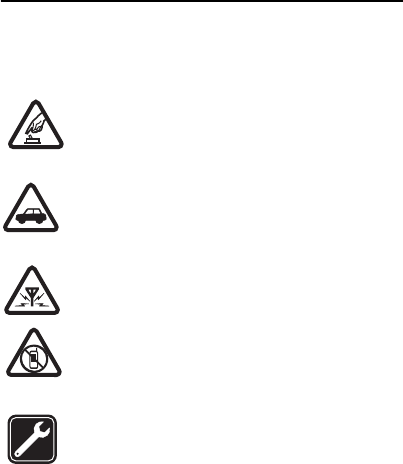
8
For your safety
Read these simple guidelines. Not following them may be
dangerous or illegal. Read the complete user guide for further
information.
SWITCH ON SAFELY
Do not switch the device on when wireless phone
use is prohibited or when it may cause interference
or danger.
ROAD SAFETY COMES FIRST
Obey all local laws. Always keep your hands free to
operate the vehicle while driving. Your first
consideration while driving should be road safety.
INTERFERENCE
All wireless devices may be susceptible to
interference, which could affect performance.
SWITCH OFF IN RESTRICTED AREAS
Follow any restrictions. Switch the device off in
aircraft, near medical equipment, fuel, chemicals, or
blasting areas.
QUALIFIED SERVICE
Only qualified personnel may install or repair this
product.

9
ENHANCEMENTS AND BATTERIES
Use only approved enhancements and batteries. Do
not connect incompatible products.
WATER-RESISTANCE
Your device is not water-resistant. Keep it dry.
■About your device
The wireless device described in this guide is approved for use on
the EGSM 900 and 1800 network. Contact your service provider
for more information about networks.
When using the features in this device, obey all laws and respect
local customs, privacy and legitimate rights of others, including
copyrights.
Copyright protection may prevent some images, music, and other
content from being copied, modified, or transferred.
Your device may have preinstalled bookmarks and links for third-
party internet sites. You may also access other third-party sites
through your device. Third-party sites are not affiliated with
Nokia, and Nokia does not endorse or assume liability for them. If
you choose to access such sites, you should take precautions for
security or content.
Warning: To use any features in this device, other than
the alarm clock, the device must be switched on. Do
10
not switch the device on when wireless device use may cause
interference or danger.
Remember to make back-up copies or keep a written record of all
important information stored in your device.
When connecting to any other device, read its user guide for
detailed safety instructions. Do not connect incompatible
products.
■Network services
To use the phone you must have service from a wireless service
provider. Many of the features require special network features.
These features are not available on all networks; other networks
may require that you make specific arrangements with your
service provider before you can use the network services. Your
service provider can give you instructions and explain what
charges will apply. Some networks may have limitations that
affect how you can use network services. For instance, some
networks may not support all language-dependent characters
and services.
Your service provider may have requested that certain features be
disabled or not activated in your device. If so, these features will
not appear on your device menu. Your device may also have a
special configuration such as changes in menu names, menu
order, and icons. Contact your service provider for more
information.
11
This device supports WAP 2.0 protocols (HTTP and SSL) that run
on TCP/IP protocols. Some features of this device, such as
multimedia messaging (MMS), browsing, and e-mail application
require network support for these technologies.
■Shared memory
The following features in this device may share memory:
multimedia messaging (MMS), e-mail application, instant
messaging. Use of one or more of these features may reduce the
memory available for the remaining features sharing memory.
Your device may display a message that the memory is full when
you try to use a shared memory feature. In this case, delete some
of the information or entries stored in the shared memory
features before continuing.

12
General information
■Access codes
The security code helps to protect your phone against
unauthorised use. You can create and change the code,
and set the phone to request the code. Keep the code
secret and in a safe place separate from your phone. If you
forget the code and your phone is locked, your phone will
require service and additional charges may apply. For
more information, contact a Nokia Care point or your
phone dealer.
The PIN code supplied with the SIM card protects the card
against unauthorized use. The PIN2 code supplied with
some SIM cards is required to access certain services. If
you enter the PIN or PIN2 code incorrectly three times in
succession, you are asked for the PUK or PUK2 code. If you
do not have them, contact your service provider.
The module PIN is required to access the information in
the security module of your SIM card. The signing PIN may
be required for the digital signature. The barring password
is required when using the call barring service.
13
To set how your phone uses the access codes and security
settings, select Menu > Settings > Security.
■Nokia support
Check www.nokia.com/support or your local Nokia website for
the latest version of this guide, additional information,
downloads, and services related to your Nokia product.
Configuration settings service
You may find PC Suite and related information on the
Nokia website at www.nokia.com/support.
Nokia Care services
If you need to contact Nokia Care services, check the list
of local Nokia Care contact centres at www.nokia.com/
customerservice.
Maintenance
For maintenance services, check your nearest Nokia Care
point at www.nokia.com/repair.
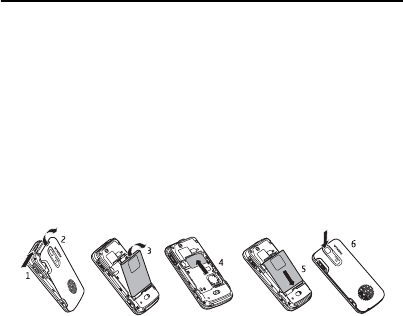
14
1. Get started
■Install the SIM card and battery
Always switch the device off and disconnect the charger
before removing the battery.
The SIM card and its contacts can be easily damaged by
scratches or bending, so be careful when handling,
inserting, or removing the card.
1. Slide the release button (1), and remove the back cover
(2).
2. Remove the battery (3), and insert the SIM card (4).
3. Insert the battery (5), and replace the back cover (6).
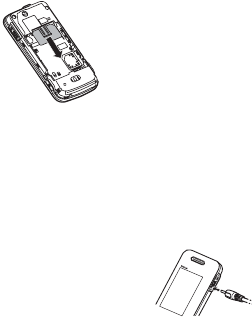
15
■Remove the SIM card
Pull the handle toward the bottom of the phone, and
remove the SIM card.
■Charge the battery
Your battery has been precharged, but the charging levels
may vary.
1. Connect the charger to a wall outlet.
2. Connect the charger to the device.
You can use your device while it is
charging.
3. When the battery is fully charged, disconnect the
charger from the device, then from the wall outlet.
If the battery is completely discharged, it may take several
minutes before the charging indicator appears on the
display or before any calls can be made.

16
■Antenna
Your device may have internal and external
antennas. As with any radio transmitting device,
avoid touching the antenna area unnecessarily
while the antenna is transmitting or receiving.
Contact with such an antenna affects the communication quality
and may cause the device to operate at a higher power level than
otherwise needed and may reduce the battery life.
■Headset
Warning: Listen to music at a moderate level.
Continuous exposure to high volume may damage
your hearing. Do not hold the device near your ear
when the loudspeaker is in use, because the volume
may be extremely loud.
Warning: When you use the headset, your ability to
hear outside sounds may be affected. Do not use the
headset where it can endanger your safety.
Do not connect products that create an output signal as this may
cause damage to the device. Do not connect any voltage source
to the Nokia AV Connector.
When connecting any external device or any headset, other than
those approved by Nokia for use with this device, to the Nokia AV
Connector, pay special attention to volume levels.
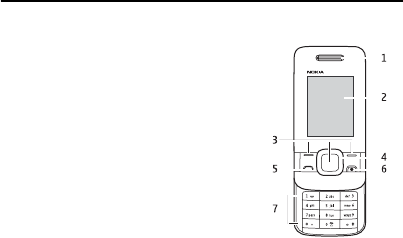
17
■Magnets and magnetic fields
Keep your device away from magnets or magnetic fields as they
may cause some applications, such as the camera, to activate
unexpectedly.
2. Your phone
■Keys and parts
• Earpiece (1)
• Display (2)
• Selection keys (3)
• Navi™ key (hereafter referred to
as scroll key) (4)
• Call key (5)
• End/Power key (6)
• Keypad (7)
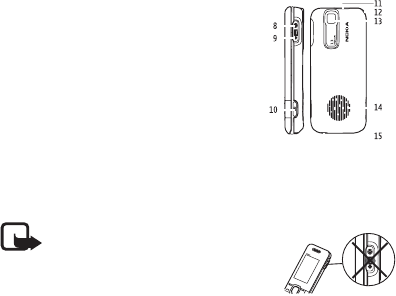
18
• Headset connector/Nokia AV
Connector (2.5 mm) (8)
• Charger connector (9)
• Camera key (10)
• Release button (11)
• Strap eyelet (12)
• Camera lens (13)
• Loudspeaker (14)
• Microphone (15)
Note: Avoid touching this
connector as it is intended for
use by authorised service
personnel only.
■Switch the phone on and off
To switch the phone on or off, press and hold the power
key.
■Standby mode
When the phone is ready for use, and you have not
entered any characters, the phone is in the standby mode:

19
Network signal strength (1)
Battery charge level (2)
Network name or operator logo (3)
Functions of selection keys (4)
The left selection key is Go to for you to view the
functions in your personal shortcut list. When viewing the
list, select Options > Select options to view the available
functions, or select Options > Organise to arrange the
functions of your shortcut list.
■Keypad lock
To prevent accidental keypresses, close the pone, and
select Lock within 5 seconds to lock the keypad.
To unlock the keypad, select Unlock > OK, or open the
phone.If the security keyguard is on, enter the security
code when requested.
To set the keypad to lock automatically after a preset time
delay when the phone is in the standby mode, select
Menu > Settings > Phone > Automatic keyguard > On.

20
To answer a call when the keypad is locked, press the call
key. When you end or reject the call, the keypad locks
automatically.
When the device or keypad is locked, calls may be possible to the
official emergency number programmed into your device.
■Functions without a SIM card
Some functions of your phone may be used without
inserting a SIM card, such as Organiser functins and
games. Some functions appear dimmed in the menus and
cannot be used.
■Applications running in background
Leaving applications running in the background increases the
demand on battery power and reduces the battery life.
3. Calls
■Make and answer a call
To make a call, enter the phone number, including the
country code and area code if necessary. Press the call key
to call the number. Scroll up to increase or down to
decrease the volume of the earpiece or headset during the
phone call.

21
To answer an incoming call, press the call key. To reject
the call without answering, press the end key.
■Loudspeaker
If available, you may select Loudsp. or Handset to use the
loudspeaker or the earpiece of the phone during a call.
Warning: Do not hold the device near your ear
when the loudspeaker is in use, because the
volume may be extremely loud.
■Dialling shortcuts
To assign a phone number to one of the number keys, 2 to
9, select Menu >Contacts > Speed dials, scroll to a desired
number, and select Assign. Enter the desired phone
number, or select Search and a saved contact.
To switch the speed dialling function on, select Menu >
Settings > Call > Speed dialling > On.
To make a call using speed dialling, in the standby mode,
press and hold the desired number key.
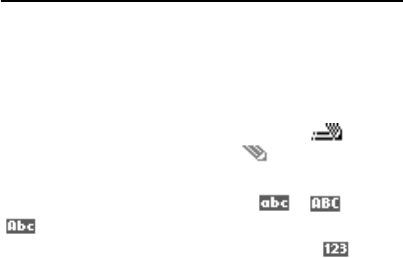
22
4. Write text
■Text mode
To enter text (for example, when writing messages) you
can use traditional or predictive text input.
When you write text, press and hold Options to toggle
between traditional text input, indicated by , and
predictive text input, indicated by . Not all languages
are supported by predictive text input.
The character cases are indicated by , , and
. To change the character case,press #. To change
from the letter to number mode, indicated by , press
and hold #, and select Number mode. To change from the
number to the letter mode, press and hold #.
To set the writing language, select Options > Writing
language.
■Traditional text input
Press a number key, 2 to 9, repeatedly until the desired
character appears. The available characters depend on the
selected writing language.
23
If the next letter you want is located on the same key as
the present one, wait until the cursor appears and enter
the letter.
To access the most common punctuation marks and
special characters, repeatedly press the number key 1 or
press * to select a special character.
■Predictive text input
Predictive text input is based on a built-in dictionary to
which you can also add new words.
1. Start writing a word, using the keys 2 to 9. Press each
key only once for one letter.
2. To confirm a word, scroll right or add a space by
pressing 0.
• If the word is not correct, press * repeatedly, and
select the word from the list.
• If the ? character is displayed after the word, the
word you intended to write is not in the dictionary.
To add the word to the dictionary, select Spell.
Enter the word using traditional text input, and
select Save.

24
• To write compound words, enter the first part of the
word, and scroll right to confirm it. Write the last
part of the word, and confirm the word.
3. Start writing the next word.
5. Navigate the menus
The phone functions are grouped into menus. Not all
menu functions or option items are described here.
In the standby mode, select Menu and the desired menu
and submenu. Select Exit or Back to exit the current level
of menu. Press the end key to return to the standby mode
directly. To change the menu view, select Menu >
Options > Main menu view.
6. Messaging
You can read, write, send, and save text, multimedia,
audio, and flash messages, and email. The messaging
services can only be used if your network or service
provider supports them.
25
■Text and multimedia messages
You can create a message and optionally attach, for
example, a picture. Your phone automatically changes a
text message to a multimedia message when a file is
attached.
Text messages
Your device supports text messages beyond the limit for a single
message. Longer messages are sent as two or more messages.
Your service provider may charge accordingly. Characters with
accents or other marks, and characters from some language
options, take up more space, and limit the number of characters
that can be sent in a single message.
An indicator at the top of the display shows the total
number of characters left and the number of messages
needed for sending.
Before you can send any text or SMS e-mail messages,
you must save your message centre number. Select
Menu > Messaging > Message settings > Text
messages > Message centres > Add centre, enter a name,
and the number from the service provider.

26
Multimedia messages
A multimedia message can contain text, pictures, sound
clips, and video clips.
Only devices that have compatible features can receive and
display multimedia messages. The appearance of a message may
vary depending on the receiving device.
The wireless network may limit the size of MMS messages. If the
inserted picture exceeds this limit, the device may make it smaller
so that it can be sent by MMS.
Important: Exercise caution when opening
messages. Messages may contain malicious
software or otherwise be harmful to your
device or PC.
Create a text or multimedia message
Select Menu > Messaging > Create message > Message.
To add recipients, scroll to the To: field, and enter the
recipient’s number or e-mail address, or select Add to
select recipients from the available options. Select
Options to add recipients and subjects and to set sending
options.
Scroll to the Text: field, and enter the message text.
27
To attach content to the message, scroll to the
attachment bar at the bottom of the display and select
the desired type of content.
To send the message, press Send.
The message type is indicated at the top of the display and
changes automatically depending on the content of the
message
Service providers may charge differently depending on the
message type. Check with your service provider for details.
■E-mail
Access your POP3 or IMAP4 e-mail account with your
phone to read, write, and send email. This e-mail
application is different from the SMS e-mail function.
Before you can use e-mail, you must have an e-mail
account and the correct settings. To check the availability
and the settings of your e-mail account, contact your e-
mail service provider. You may receive the e-mail
configuration settings as a configuration message.
E-mail setup wizard
The e-mail setup wizard starts automatically if no e-mail
settings are defined in the phone. To start the setup

28
wizard for an additional e-mail account, select Menu >
Messaging and the existing e-mail account. Select
Options >Add mailbox to start the e-mail setup wizard.
Follow the instructions on the display.
Write and send an e-mail
To write an e-mail, select Menu > Messaging > Create
message > E-mail message. To attach a file to the e-mail,
select Options > Insert. To send the email, press the call
key. Select the desired account if necessary.
Download e-mail
Important: Exercise caution when opening
messages. Messages may contain malicious
software or otherwise be harmful to your device
or PC.
To select the retrieve mode, select Menu > Messaging >
Message settings > E-mail messages > Edit mailboxes and
the desired mailbox, and select Downloading sett. >
Retrieve mode.
To download e-mail, select Menu > Messaging and the
desired mail box; confirm the query for connection if
necessary.
29
■Flash messages
Flash messages are text messages that are instantly
displayed upon reception.
Select Menu > Messaging > Create message > Flash
message.
Enter the recipient’s phone number, write your message
(maximum 70 characters), and select Send.
■Nokia Xpress audio messages
Create and send an audio message using MMS in a
convenient way.
Select Menu > Messaging > Create message > Audio
message. The recorder opens.
Record your message.
Enter one or more phone numbers in the To: field, or select
Add to retrieve a number.
To send the message, select Send.
■Instant messaging
With instant messaging (IM, network service) you can
send short text messages to online users. You must
subscribe to a service and register with the IM service you
30
want to use. Check the availability of this service, pricing,
and instructions with your service provider. The menus
may vary depending on your IM provider.
To connect to the service, select Menu > Messaging >
Create message > IMs, and follow the instructions on the
display.
■Voice messages
The voice mailbox is a network service to which you may
need to subscribe. For more information, contact your
service provider.
To call your voice mailbox, press and hold 1.
To edit your voice mailbox number, select Menu >
Messaging > Voice messages > Voice mailbox no..
■Message settings
Select Menu > Messaging > Message settings to set up
your messaging features.
General settings—to set your phone to save sent
messages, to allow overwriting of older messages if the
message memory is full, and to set up other preferences
related to messages

31
Text messages—to allow delivery reports, to set up
message centers for SMS and SMS e-mail, to select the
type of character support, and to set up other preferences
related to text messages
Multimedia messages—to allow delivery reports, to set up
the appearance of multimedia messages, to allow the
reception of multimedia messages and adverts, and to set
up other preferences related to multimedia messages
E-mail messages—to allow e-mail reception, to set the
image size in e-mail, and to set up other preferences
related to e-mail
7. Contacts
Select Menu > Contacts.
You can save names and phone numbers in the phone
memory and SIM card memory. In the phone memeory,
you can save contacts with numbers and text items.
Names and numbers saved in the SIM card memory are
indicated by .
To add contact, select Menu > Contacts > Names >
Options > Add new contact. To add details to a contact,
32
ensure that the memory in use is either Phone or Phone
and SIM. Scroll to the name, and select Details >
Options > Add detail
To search for a contact, select Names, and scroll through
the list of contacts or enter the first letters of the name.
To copy a contact between the phone memory and SIM
card memory, select Names, scroll to the contact, and
select Options > Copy contact. In the SIM card memory,
you can save only one phone number for each name.
To select the SIM card or phone memory for your contacts,
to select how the names and numbers in contacts are
displayed, and to view the memory capacity for contacts,
select Settings.
You can send and receive a person’s contact information
from a compatible device that supports the vCard
standard as a business card. To send a business card, select
Names, search for the contact whose information you
want to send, and select Details > Options > Send
business card.

33
8. Call log
To view the information on your calls, select Menu > Log.
Available options may include the following:
All calls—to view your recently missed and received calls
and dialled numbers chronologically
Missed calls, Received calls, or Dialled numbers—for
information about your recent calls
Msg. recipients—to view the contacts to whom you most
recently sent messages
Call duration, Data counter, or Pack. data timer—to view
the general information on your recent communications
Message log, or Sync log—to view the number of sent and
received messages or synchronisations
Note: The actual invoice for calls and services
from your service provider may vary,
depending on network features, rounding off
for billing, taxes, and so forth.

34
9. Settings
■Profiles
Your phone has various setting groups called profiles,
which you can customise with ringing tones for different
events and environments.
Select Menu > Settings > Profiles, the desired profile, and
from the following options:
Activate—to activate the selected profile
Personalise—change the profile settings
Timed—to set the profile to be active for a certain time.
When the time set for the profile expires, the previous
profile that was not timed becomes active.
■Tones
You can change the tone settings of the selected active
profile.
Select Menu > Settings > Tones. You can find the same
settings in the Profiles menu.
If you select the highest ringing tone level, the ringing tone
reaches its highest level after a few seconds.
35
■Display
To view or adjust the wallpaper, font size, or other
features related to the phone display, select Menu >
Settings > Display.
■Date and time
Select Menu > Settings > Date and time.
To set the date and time, select Date & time settings.
To set the formats for date and time, select Date and time
format.
To set the phone to update the time and date
automatically according to the current time zone, select
Auto-update of time (network service).
■Shortcuts
With personal shortcuts, you can get quick access to
frequently used phone functions. Select Menu >
Settings > My shortcuts.
To allocate one phone function to the right or left
selection key, select Right selection key or Left selection
key.
36
To select shortcut functions for the scroll key, select
Navigation key. Scroll to the desired direction, and select
Change or Assign and a function from the list.
■Synchronisation and backup
Select Menu > Settings > Sync and backup.
Phone switch—Synchronise or copy selected data between
your phone and another phone using Bluetooth
technology.
Data transfer—Synchronise or copy selected data between
your phone and another device, PC, or network server
(network service).
■Connectivity
Your phone has several features that allow you to connect
to other devices to transmit and receive data.
Bluetooth wireless technology
Bluetooth technology allows you to connect your phone,
using radio waves, to a compatible Bluetooth device
within 10 metres (32 feet).
This device is compliant with Bluetooth Specification 2.0 + EDR
supporting the following profiles: generic access, network access,
control, hands-free, headset, object push, file transfer, dial-up

37
networking, SIM access, and serial port. To ensure
interoperability between other devices supporting Bluetooth
technology, use Nokia approved enhancements for this model.
Check with the manufacturers of other devices to determine their
compatibility with this device.
Features using Bluetooth technology increase the demand on
battery power and reduce the battery life.
Set up a Bluetooth connection
Select Menu > Settings > Connectivity > Bluetooth and
take the following steps:
Select My phone's nameand enter a name for your phone.
To activate Bluetooth connectivity select Bluetooth > On.
indicates that Bluetooth is active.
To connect your phone with an audio enhancement, select
Connect audio enhan. and the device that you want to
connect to.
To pair your phone with any Bluetooth device in range,
select Paired devices > Add new device. Scroll to a found
device, and select Add.
Enter a passcode (up to 16 characters) on your phone and
allow the connection on the other Bluetooth device.
38
If you are concerned about security, turn off the Bluetooth
function, or set My phone's visibility to Hidden. Accept
Bluetooth communication only from those you trust.
PC connection to the internet
Use Bluetooth technology to connect your compatible PC
to the internet without PC Suite software. Your phone
must have activated a service provider that supports
internet access, and your PC has to support Bluetooth
personal area network (PAN). After connecting to the
network access point (NAP) service of the phone, and
pairing with your PC, your phone automatically opens a
packet data connection to the internet.
Packet data
General packet radio service (GPRS) is a network service
that allows mobile phones to send and receive data over
an internet protocol (IP)-based network.
To define how to use the service, select Menu >
Settings > Connectivity > Packet data > Packet data conn.
and from the following options:
When needed—to establish the packet data connection
when an application needs it. The connection is closed
when the application is terminated.
39
Always online—to automatically connect to a packet data
network when you switch the phone on
You can use your phone as a modem by connecting it to a
compatible PC using Bluetooth technology. For details,
see the Nokia PC Suite documentation.
■Call and phone
Select Menu > Settings > Call.
To divert your incoming calls, select Call divert (network
service). For details, contact your service provider.
To make ten attempts to connect the call after an
unsuccessful attempt, select Automatic redial > On.
To have the network notify you of an incoming call while
you are in a call, select Call waiting > Activate.
To set whether to show your number to the person you are
calling, select Send my caller ID (network service).
To set the display language of your phone, select Menu >
Settings > Phone > Language settings > Phone language.
40
■Enhancements
This menu and its various options are shown only if the
phone is or has been connected to a compatible mobile
enhancement.
Select Menu > Settings > Enhancements. Select an
enhancement, and an option depending on the
enhancement.
■Configuration
You can configure your phone with settings that are
required for certain services. Your service provider may
also send you these settings.
Select Menu > Settings > Configuration and from the
following:
Default config. sett.—to view the service providers stored
in the phone and set a default service provider
Act. def. in all apps.—to activate the default configuration
settings for supported applications
Preferred access pt.—to view the saved access points
Connect to support—to download the configuration
settings from your service provider

41
Personal config. sett.—to manually add new personal
accounts for various services and to activate or delete
them. To add a new personal account, select Add or
Options > Add new. Select the service type, and enter the
required parameters. To activate a personal account, scroll
to it, and select Options > Activate.
■Restore factory settings
To restore the phone back to factory conditions, select
Menu > Settings > Rest. factory sett. and fromthe
following options:
Restore settings only—to reset all preference settings
without deleting any personal data
Restore all—to reset all preference settings and delete all
personal data, such as contacts, messages, media files and
activation keys
10. Operator menu
Access a portal to services provided by your network
operator. For more information, contact your network
operator. The operator can update this menu with a
service message.

42
11. Gallery
Digital rights management (DRM) protected content comes with
an associated activation key that defines your rights to use the
content.
If your device has OMA DRM-protected content, to back up both
the activation keys and the content, use the backup feature of
Nokia PC Suite. Other transfer methods may not transfer the
activation keys which need to be restored with the content for
you to be able to continue the use of OMA DRM- protected
content after the device memory is formatted. You may also need
to restore the activation keys in case the files on your device get
corrupted.
Your phone supports a digital rights management (DRM)
system to protect acquired content. Always check the
delivery terms of any content and activation key before
acquiring them, as they may be subject to a fee.
To view the folders, select Menu > Gallery.

43
12. Media
■Camera and video
Your device supports an image capture resolution of 12800x1024
pixels.
Take a picture
To use the still image function, select Menu > Media >
Camera, or if the video function is on, scroll left or right.
To capture an image, select Capture.
To zoom in or out in camera mode, scroll up or down.
To set the camera to night mode, to set the self-timer on,
or to take images in a fast sequence, select Options and
the desired option. To set the preview mode and time,
select Options > Settings > Image preview time.
Record a video clip
To use the video function, select Menu > Media > Video.
To start the video recording, select Record.
To set the length of the video clip you can take, select
Menu > Media > Camera > Options > Settings > Video
clip length.

44
■FM radio
The FM radio depends on an antenna other than the wireless
device antenna. A compatible headset or enhancement needs to
be attached to the device for the FM radio to function properly.
Warning: Listen to music at a moderate level.
Continuous exposure to high volume may damage
your hearing. Do not hold the device near your ear
when the loudspeaker is in use, because the volume
may be extremely loud.
Select Menu > Media > Radio or, in the standby mode,
press and hold *.
If you have already saved radio stations, scroll left or right
to switch between the stations, or press the
corresponding number keys of the memory location of the
desired station.
To search for a neighboring station, press and hold the
scroll key left or right.
To save the station to which you are tuned, select
Options > Save station.
To adjust the volume, scroll up or down.

45
To leave the radio playing in the background, press the
end key. To switch off the radio, press and hold the end
key.
■Voice recorder
The recorder cannot be used when a data call or GPRS connection
is active.
To start recording, select Menu > Media > Voice recorder
and the virtual record button on the display.
To listen to the latest recording, select Options > Play last
recorded. To send the last recording using a multimedia
message, select Options > Send last recorded.
■Music player
Your phone includes a music player for listening to songs
or other MP3 or AAC sound files.
Warning: Listen to music at a moderate level.
Continuous exposure to high volume may damage
your hearing. Do not hold the device near your ear
when the loudspeaker is in use, because the volume
may be extremely loud.
Select Menu > Media > Music player.
To start or pause playing, press the middle selection key.

46
To skip to the beginning of the current track, scroll left.
To skip to the previous track, press the scroll key to the left
twice.
To skip to the next track, scroll right.
To rewind, press and hold the scroll key to the left.
To fast-forward, press and hold the scroll key to the right.
To adjust the volume, scroll up or down.
To mute or unmute the music player, press #.
To leave the music player playing in the background, press
the end key. To stop the music player, press and hold the
end key.
13. Applications
Your phone software may include some games and Java
applications specially designed for this Nokia phone.
Select Menu > Applications.
To launch a game or application, select Applications >
Games, or Collection. Scroll to a game or application, and
select Open.

47
To view the amount of memory available for game and
application installations, select Options > Memory status.
To download a game or application, select Options >
Downloads >Game downloads or App. downloads. Your
phone supports J2ME™ Java applications. Ensure that the
application is compatible with your phone before
downloading it.
Important: Only install and use applications
and other software from trusted sources, such
as applications that are Symbian Signed or
have passed the Java VerifiedTM testing.
Downloaded applications may be saved in the Gallery
menu instead of Applications.
14. Organiser
■Alarm clock
Select Menu > Organiser > Alarm clock.
To set the alarm on or off, select Alarm:. To set the time for
the alar, select Alarm time:. To set the phone to alert you
on selected days of the week, select Repeat:. To set the
time out for the snooze alert, select Snooze time-out:.

48
To stop the alarm, select Stop. If you let the phone
continue to sound the alarm for a minute or select
Snooze, the alarm stops for the snooze time-out, then
resumes.
■Calendar and to-do list
Select Menu > Organiser > Calendar. The current day is
framed. If there are any notes set for the day, the day is in
bold.
To make a calendar note, scroll to the date, and select
Options > Make a note.
To view the day notes, select View. To delete all notes in
the calendar, select Options > Delete notes > All notes.
To view the to-do list, select Menu > Organiser > To-do
list. The to-do list is displayed and sorted by priority. To
add, delete, or send a note, to mark the note as done, or to
sort the to-do list by deadline, select Options.
15. Web
You can access various internet services with your phone
browser. The appearance of the internet pages may vary

49
due to screen size. You may not be able to see all the
details on the internet pages.
Important: Use only services that you trust
and that offer adequate security and
protection against harmful software.
For the availability of these services, pricing, and
instructions, contact your service provider.
You may receive the configuration settings required for
browsing as a configuration message from your service
provider.
■Connect to a service
To make a connection to the service, select Menu >
Web > Home; or in the standby mode, press and hold 0.
After you make a connection to the service, you can start
browsing its pages. The function of the phone keys may
vary in different services. Follow the text guides on the
phone display. For more information, contact your service
provider.
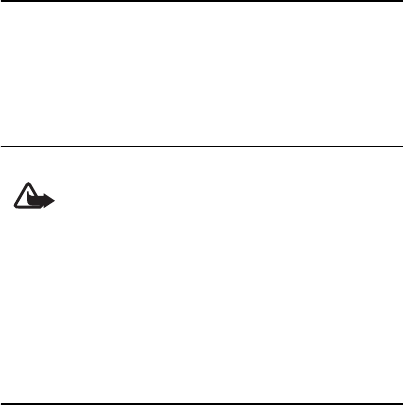
50
16. SIM services
Your SIM card may provide additional services. You can
access this menu only if it is supported by your SIM card.
The name and contents of the menu depend on the
available services.
17. Enhancements
Warning: Use only batteries, chargers, and
enhancements approved by Nokia for use with this
particular model. The use of any other types may
invalidate any approval or warranty, and may be
dangerous.
For availability of approved enhancements, please check with
your dealer. When you disconnect the power cord of any
enhancement, grasp and pull the plug, not the cord.
18. Battery and charger
information
Your device is powered by a rechargeable battery. The battery
intended for use with this device is BL-4S. This device is intended
51
for use when supplied with power from the following chargers:
AC-3. The battery can be charged and discharged hundreds of
times, but it will eventually wear out. When the talk and standby
times are noticeably shorter than normal, replace the battery. Use
only Nokia approved batteries, and recharge your battery only
with Nokia approved chargers designated for this device. Use of
an unapproved battery or charger may present a risk of fire,
explosition, leakage, or other hazard.
If a battery is being used for the first time or if the battery has not
been used for a prolonged period, it may be necessary to connect
the charger, then disconnect and reconnect it to begin charging
the battery. If the battery is completely discharged, it may take
several minutes before the charging indicator appears on the
display or before any calls can be made.
Always switch the device off and disconnect the charger before
removing the battery.
Unplug the charger from the electrical plug and the device when
not in use. Do not leave a fully charged battery connected to a
charger, since overcharging may shorten its lifetime. If left
unused, a fully charged battery will lose its charge over time.
Always try to keep the battery between 15°C and 25°C (59°F and
77°F). Extreme temperatures reduce the capacity and lifetime of
the battery. A device with a hot or cold battery may not work
52
temporarily. Battery performance is particularly limited in
temperatures well below freezing.
Do not short-circuit the battery. Accidental short-circuiting can
occur when a metallic object such as a coin, clip, or pen causes
direct connection of the positive (+) and negative (-) terminals of
the battery. (These look like metal strips on the battery.) This
might happen, for example, when you carry a spare battery in
your pocket or purse. Short-circuiting the terminals may damage
the battery or the connecting object.
Do not dispose of batteries in a fire as they may explode.
Batteries may also explode if damaged. Dispose of batteries
according to local regulations. Please recycle when possible. Do
not dispose as household waste.
Do not dismantle, cut, open, crush, bend, deform, puncture, or
shred cells or batteries. In the event of a battery leak, do not
allow the liquid to come in contact with the skin or eyes. In the
event of such a leak, flush your skin or eyes immediately with
water, or seek medical help.
Do not modify, remanufacture, attempt to insert foreign objects
into the battery, or immerse or expose it to water or other liquids.
Improper battery use may result in a fire, explosion, or other
hazard. If the device or battery is dropped, especially on a hard
surface, and you believe the battery has been damaged, take it to
a service centre for inspection before continuing to use it.
53
Use the battery only for its intended purpose. Never use any
charger or battery that is damaged. Keep your battery out of the
reach of small children.
■Nokia battery authentication
guidelines
Always use original Nokia batteries for your safety. To check that
you are getting an original Nokia battery, purchase it from an
authorised Nokia dealer, and inspect the hologram label using the
following steps:
Successful completion of the steps is not a total assurance of the
authenticity of the battery. If you have any reason to believe that
your battery is not an authentic, original Nokia battery, you
should refrain from using it, and take it to the nearest authorised
Nokia service point or dealer for assistance. Your authorised
Nokia service point or dealer will inspect the battery for
authenticity. If authenticity cannot be verified, return the battery
to the place of purchase.
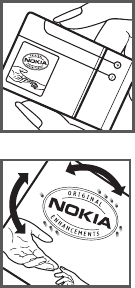
54
Authenticate hologram
1. When you look at the
hologram on the label, you should
see the Nokia connecting hands
symbol from one angle and the
Nokia Original Enhancements
logo when looking from another
angle.
2.= When you angle the
hologram left, right, down and up,
you should see 1, 2, 3 and 4 dots
on each side respectively.
What if your battery is not authentic?
If you cannot confirm that your Nokia battery with the hologram
on the label is an authentic Nokia battery, please do not use the
battery. Take it to the nearest authorised Nokia service point or
dealer for assistance. The use of a battery that is not approved by
the manufacturer may be dangerous and may result in poor

55
performance and damage to your device and its enhancements. It
may also invalidate any approval or warranty applying to the
device.
To find out more about original Nokia batteries, visit
www.nokia.com/battery.
Care and maintenance
Your device is a product of superior design and craftsmanship and
should be treated with care. The following suggestions will help
you protect your warranty coverage.
• Keep the device dry. Precipitation, humidity, and all types of
liquids or moisture can contain minerals that will corrode
electronic circuits. If your device does get wet, remove the
battery, and allow the device to dry completely before
replacing it.
• Do not use or store the device in dusty, dirty areas. Its moving
parts and electronic components can be damaged.
• Do not store the device in hot areas. High temperatures can
shorten the life of electronic devices, damage batteries, and
warp or melt certain plastics.
• Do not store the device in cold areas. When the device returns
to its normal temperature, moisture can form inside the
device and damage electronic circuit boards.
56
• Do not attempt to open the device other than as instructed in
this guide.
• Do not drop, knock, or shake the device. Rough handling can
break internal circuit boards and fine mechanics.
• Do not use harsh chemicals, cleaning solvents, or strong
detergents to clean the device.
• Do not paint the device. Paint can clog the moving parts and
prevent proper operation.
• Use a soft, clean, dry cloth to clean any lenses, such as
camera, proximity sensor, and light sensor lenses.
• Use only the supplied or an approved replacement antenna.
Unauthorised antennas, modifications, or attachments could
damage the device and may violate regulations governing
radio devices.
• Use chargers indoors.
• Always create a backup of data you want to keep, such as
contacts and calendar notes.
• To reset the device from time to time for optimum
performance, power off the device and remove the battery.
These suggestions apply equally to your device, battery, charger,
or any enhancement. If any device is not working properly, take it
to the nearest authorised service facility for service.

57
Disposal
The crossed-out wheeled-bin symbol on your product,
literature, or packaging reminds you that all electrical
and electronic products, batteries, and accumulators
must be taken to separate collection at the end of
their working life. This requirement applies to the
European Union and other locations where separate
collection systems are available. Do not dispose of
these products as unsorted municipal waste.
By returning the products to collection you help
prevent uncontrolled waste disposal and promote the
reuse of material resources. More detailed information
is available from the product retailer, local waste
authorities, national producer responsibility
organizations, or your local Nokia representative. For
the product Eco-Declaration or instructions for
returning your obsolete product, go to country-
specific information at www.nokia.com.
Additional safety information
■Small children
Your device and its enhancements may contain small parts. Keep
them out of the reach of small children.
58
■Operating environment
This device meets RF exposure guidelines when used either in the
normal use position against the ear or when positioned at least
2.2 centimeters (7/8 inches) away from the body. When a carry
case, belt clip, or holder is used for body-worn operation, it
should not contain metal and should position the device the
above-stated distance from your body.To transmit data files or
messages, this device requires a quality connection to the
network. In some cases, transmission of data files or messages
may be delayed until such a connection is available. Ensure the
above separation distance instructions are followed until the
transmission is completed.
Parts of the device are magnetic. Metallic materials may be
attracted to the device. Do not place credit cards or other
magnetic storage media near the device, because information
stored on them may be erased.
■Vehicles
RF signals may affect improperly installed or inadequately
shielded electronic systems in motor vehicles such as electronic
fuel injection systems, electronic antiskid (antilock) braking
systems, electronic speed control systems, and air bag systems.
For more information, check with the manufacturer, or its
representative, of your vehicle or any equipment that has been
added.
59
Only qualified personnel should service the device or install the
device in a vehicle. Faulty installation or service may be
dangerous and may invalidate any warranty that may apply to
the device. Check regularly that all wireless device equipment in
your vehicle is mounted and operating properly. Do not store or
carry flammable liquids, gases, or explosive materials in the same
compartment as the device, its parts, or enhancements. For
vehicles equipped with an air bag, remember that air bags inflate
with great force. Do not place objects, including installed or
portable wireless equipment in the area over the air bag or in the
air bag deployment area. If in-vehicle wireless equipment is
improperly installed and the air bag inflates, serious injury could
result.
Using your device while flying in aircraft is prohibited. Switch off
your device before boarding an aircraft. The use of wireless
teledevices in an aircraft may be dangerous to the operation of
the aircraft, disrupt the wireless telephone network, and may be
illegal.
■Medical devices
Operation of any radio transmitting equipment, including
wireless phones, may interfere with the functionality of
inadequately protected medical devices. Consult a physician or
the manufacturer of the medical device to determine if they are
adequately shielded from external RF energy or if you have any
questions. Switch off your device in health care facilities when
60
any regulations posted in these areas instruct you to do so.
Hospitals or health care facilities may be using equipment that
could be sensitive to external RF energy.
Implanted medical devices
Manufacturers of medical devices recommend that a minimum
separation of 15.3 centimeters (6 inches) should be maintained
between a wireless device and an implanted medical device, such
as a pacemaker or implanted cardioverter defibrillator, to avoid
potential interference with the medical device. Persons who have
such devices should:
• Always keep the wireless device more than 15.3 centimeters
(6 inches) from the medical device when the wireless device is
turned on.
• Not carry the wireless device in a breast pocket.
• Hold the wireless device to the ear opposite the medical
device to minimise the potential for interference.
• Turn the wireless device off immediately if there is any reason
to suspect that interference is taking place.
• Read and follow the directions from the manufacturer of their
implanted medical device.
If you have any questions about using your wireless device with
an implanted medical device, consult your health care provider.
61
Hearing aids
Some digital wireless devices may interfere with some hearing
aids. If interference occurs, consult your service provider.
■Potentially explosive environments
Switch off your device when in any area with a potentially
explosive atmosphere, and obey all signs and instructions.
Potentially explosive atmospheres include areas where you would
normally be advised to turn off your vehicle engine. Sparks in
such areas could cause an explosion or fire resulting in bodily
injury or even death. Switch off the device at refuelling points
such as near gas pumps at service stations. Observe restrictions
on the use of radio equipment in fuel depots, storage, and
distribution areas; chemical plants; or where blasting operations
are in progress. Areas with a potentially explosive atmosphere are
often, but not always, clearly marked. They include below deck on
boats, chemical transfer or storage facilities and areas where the
air contains chemicals or particles such as grain, dust, or metal
powders. You should check with the manufacturers of vehicles
using liquefied petroleum gas (such as propane or butane) to
determine if this device can be safely used in their vicinity.

62
■Emergency calls
Important: This device operates using radio signals,
wireless networks, landline networks, and user-
programmed functions. If your device supports voice
calls over the internet (internet calls), activate both
the internet calls and the cellular phone. The device
will attempt to make emergency calls over both the
cellular networks and through your internet call
provider if both are activated. Connections in all
conditions cannot be guaranteed. You should never
rely solely on any wireless device for essential
communications like medical emergencies.
To make an emergency call:
1. If the device is not on, switch it on. Check for adequate signal
strength. Depending on your device, you may also need to
complete the following:
• Insert a SIM card if your device uses one.
• Remove certain call restrictions you have activated in
your device.
• Change your profile from offline or flight profile mode to
an active profile.
2. Press the end key as many times as needed to clear the display
and ready the device for calls.
63
3. Enter the official emergency number for your present
location. Emergency numbers vary by location.
4. Press the call key.
When making an emergency call, give all the necessary
information as accurately as possible. Your wireless device may
be the only means of communication at the scene of an accident.
Do not end the call until given permission to do so.
■Certification information (SAR)
This mobile device meets guidelines for exposure to radio
waves.
Your mobile device is a radio transmitter and receiver. It is
designed not to exceed the limits for exposure to radio waves
recommended by international guidelines. These guidelines were
developed by the independent scientific organization ICNIRP and
include safety margins designed to assure the protection of all
persons, regardless of age and health.
The exposure guidelines for mobile devices employ a unit of
measurement known as the Specific Absorption Rate or SAR. The
SAR limit stated in the ICNIRP guidelines is 2.0 watts/kilogram
(W/kg) averaged over 10 grams of tissue. Tests for SAR are
conducted using standard operating positions with the device
transmitting at its highest certified power level in all tested
frequency bands. The actual SAR level of an operating device can
be below the maximum value because the device is designed to
64
use only the power required to reach the network. That amount
changes depending on a number of factors such as how close you
are to a network base station. The highest SAR value under the
ICNIRP guidelines for use of the device at the ear is 0.53 W/kg.
Use of device accessories and enhancements may result in
different SAR values. SAR values may vary depending on national
reporting and testing requirements and the network band.
Additional SAR information may be provided under product
information at www.nokia.com.
Your mobile device is also designed to meet the requirements for
exposure to radio waves established by the Federal
Communications Commission (USA) and Industry Canada. These
requirements set a SAR limit of 1.6 W/kg averaged over one gram
of tissue. The highest SAR value reported under this standard
during product certification for use at the ear is 0.81 W/kg and
when properly worn on the body is 0.42 W/kg.